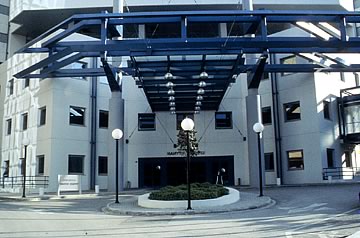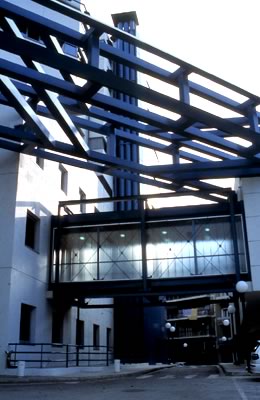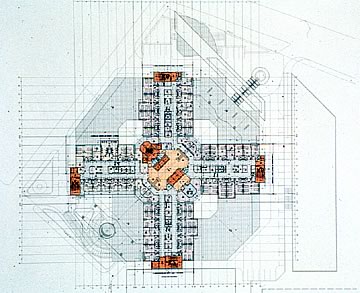
Henri Dunant Hospital
Mesogeion Ave, Sliman, Roussou & Kalamon
Sts, 1995
Architects:
Kyriakos Kyriakidis (1937-) and Associates S.A.
Harry Bougadellis (1956-) and Associate Architects
Kostas Xanthopoulos
Margarita Milissi
The Henri Dunant Hospital is the most up-to-date
hospital of the 1990s. The building, which has a total area of about
50,000 sq.m. and is 25 m. high, consists of seven floors above the ground
and two below. It has 105 beds in the surgery and pathology clinics,
78 beds in intensive care, 56 beds for out-patient treatment as well
as 20 fully equipped operating rooms and 22 specialised out-patient
clinics. In addition, it contains microbiology and haematology laboratories
as well as a radiology diagnostic section.
Architecturally, the top four floors of the building are cruciform in
shape (allusion to the shape of the Red Cross) and house the patient
care facilities. This volume is supported, with the insertion of a floor
with the electrical and mechanical installations, on a building foundation
of three floors above ground and two below. These floors serve the diagnostic,
treatment and service functions of the hospital. In the second basement
there are 81 parking places.
The vertical link between the floors is provided by a central core with
staircase and 6 lifts, and constitutes the backbone of the architectural
composition. The various departments are laid around it.
The floor plans are organised along corridors that follow the arms of
the cross as well as the ring created in the main part of the octagonal
base. At the end of the arms of the cross there are also emergency stairways
and lifts in the event of fire.
Access to the hospital is from Mesogeion Ave and leads directly to the
reception area and the out-patients’ clinics. Emergency cases and
parking facilities are through the back of the hospital on a secondary
street, Kalamon.
An amphitheatre protrudes from the main volume of the building like
a separate structure that is linked with the rest of the building by
means of bridges.
The selection of structural materials, the distribution of openings,
the chromatic and tone differences all contribute to creating an interesting
total effect.
TRANSPORTATION


